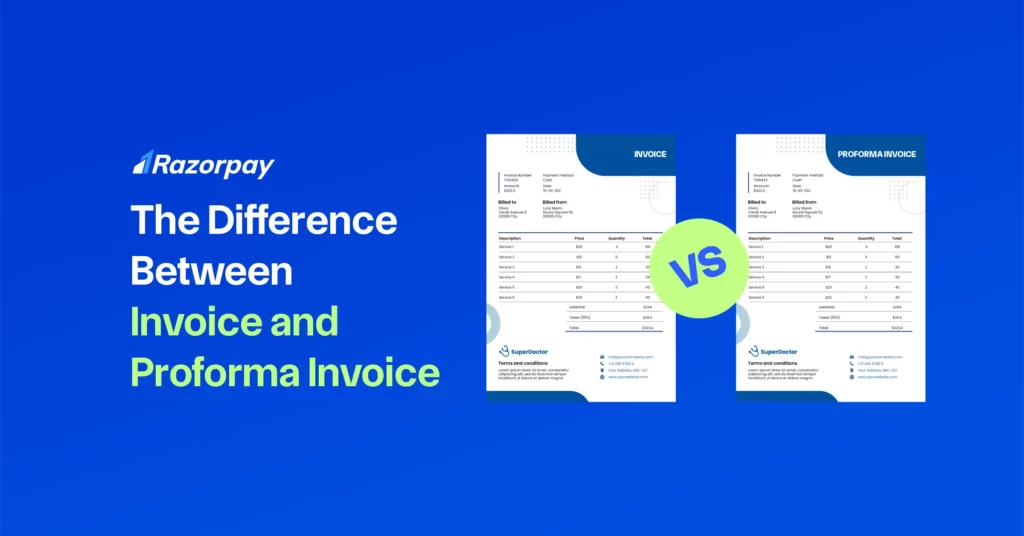In the realm of global commerce, invoices serve as the fundamental documents facilitating financial communication and accountability between parties. Among the various invoice types, standard and proforma invoices hold significant importance. Each plays a distinct role in the transaction process.
To effectively manage financial operations and mitigate risks, understanding the nuances between standard and proforma invoices is essential. This comprehensive guide illuminates the key differences between these two invoice types, empowering businesses to optimize their processes.
Table of Contents
What is a Proforma Invoice (PI)?
A proforma invoice is a preliminary, non-binding document that a seller sends to a buyer before a sale is finalized. It serves as a good-faith estimate, providing details about the goods or services to be delivered, their prices, shipping information, and delivery date. Proforma invoices are often used to request payment in advance, especially for international transactions or large orders.
Related Read: What Is a Commercial Invoice?
Elements Of A Proforma Invoice (PI)
1. Seller and Buyer Information
- Contact information
- Names
- Addresses of both parties
2. Invoice Number and Date
- Unique identifier for tracking
- Date of issuance
3. Description of Goods or Services
- List of goods or services in detail
- Unit costs
- Quantity included
4. Estimated Costs
- Cost breakdown
- Including subtotal
- Taxes
- Delivery
- Total anticipated amount included
5. Payment Terms
- Detailed instructions on how to pay
- When to pay?
- Any discounts that would be applicable
6. Validity Period
- Time frame during which the quoted prices are valid
7. Terms and Conditions
- Additional terms related to the transaction, such as warranty details and delivery timelines
8. Currency
- Transaction currency is particularly important for cross-border transactions
9. Proforma Invoice Label
- To differentiate it from a final sales invoice, it should be clearly marked as “Proforma Invoice” and “Not a Tax Invoice.
Difference Between Proforma Invoice and Invoice
Proforma invoices give an estimate of expenses and act as a preliminary or initial agreement, whereas invoices reflect an actual transaction and are legally enforceable. A proforma invoice is issued before the products or services are given, whereas an invoice is issued after delivery.
Here’s a table comparing invoice vs proforma invoice:
Invoice |
Proforma Invoice |
|
|
Definition |
Preliminary or initial document sent before shipment. |
Final document issued after goods/services have been delivered. |
|
Legal Status |
Not a legally binding document |
Legally binding document |
|
Purpose |
Offers cost estimate to the buyer |
Request payment from the buyer |
|
Payment |
No payment is expected here |
Payment is expected here |
|
Timing |
Prepared before the actual transaction |
Prepared after the transaction is completed |
|
Formality |
Less formal and detailed |
More formal and detailed |
|
Taxation |
Not used for tax calculations |
Used for tax calculations and may include taxes |
|
Revision |
Can be updated and revised |
Cannot be revised once issued |
|
Validity |
Limited validity period (usually very short-term) |
There’s no specific validity period |
|
Importance |
Low importance in accounting |
Crucial for accounting and financial records |
|
Use in International Trade |
Used for currency exchange, import license application, customs clearance, letter of credit |
Mandatory for determining taxes, customs clearance and duties, checking against letter of credit (LoC) |
Related Read: PO and Non-PO Invoices: Meaning, Differences and Examples
When Should a Proforma Invoice/Preliminary Invoice be Used?
When a buyer commits to a purchase but final details are still under negotiation, it is advisable to use a proforma invoice before completing the transaction. For example, if a business must secure funding for a significant order, a proforma invoice can benefit you by providing the appropriate estimations.
Everyday situations where proforma invoices are used:
1. International Trade
Proforma invoices are frequently issued by exporters to potential purchasers with estimated expenses and terms before exporting goods. This helps to secure letters of credit or funding agreements.
2. Pre-Payment Arrangements
A construction business may send a proforma invoice to a customer seeking upfront payment for supplies required for a project, ensuring that finances are accessible before the construction starts.
3. Customs Clearance
When exporting goods internationally, customs documentation may demand a proforma invoice stating the shipment’s contents and estimated value.
4. Internal Procurement Approvals
Businesses can use proforma invoices to acquire internal approvals for purchasing goods or services, guaranteeing all departments are in agreement on pricing and terms before finalizing the transaction.
5. Negotiation Phase
During negotiations, a supplier may submit a proforma invoice to a potential customer, allowing both parties to discuss and settle on pricing and terms before closing the deal.
Benefits of Proforma Invoice
- Enhances business professionalism: Proforma invoices create a polished and professional image for your business.
- Provides essential pre-delivery details: By outlining product specifics and estimated costs, they prepare both parties for the final transaction.
- Fosters commitment: Serving as a preliminary contract, proforma invoices solidify the intent of both buyer and seller.
- Streamlines the sales process: By providing clear expectations, proforma invoices expedite the sales cycle.
- Enables flexibility: They allow for adjustments and modifications before finalizing the deal.
- Facilitates negotiations: Proforma invoices provide a solid foundation for discussing terms and conditions.
- Improves communication: They ensure all stakeholders are aligned on the transaction details.
- Supports customs clearance: For international transactions, proforma invoices often contain the necessary information for customs procedures.
- Reduces payment disputes: Clearly defined payment terms minimize misunderstandings and late payments.
- Aids internal approvals: Businesses can use proforma invoices to secure internal sign-offs and allocate resources.
- Enhances market positioning: By demonstrating professionalism and organization, proforma invoices can improve your business’s reputation.
Sample Format of Proforma Invoice (PI)
A well-structured proforma invoice streamlines business operations by providing clear and essential information for both the buyer and seller. Below is a practical sample format you can use to create a professional Proforma Invoice:
Proforma Invoice
Proforma Invoice Number: [Unique Identifier]
Date of Issue: [DD/MM/YYYY]
Validity Period: [Start Date – End Date]
Seller Details
- Company Name
- Address
- Contact Number
- Email Address
Buyer Details
- Company/Individual Name
- Address
- Contact Number
- Email Address
Description of Goods/Services
| S. No. | Item Description | Quantity | Unit Price | Total Amount |
| 1 | [Product/Service 1] | [Qty] | [Amount] | [Amount] |
| 2 | [Product/Service 2] | [Qty] | [Amount] | [Amount] |
Subtotal: [Amount]
Taxes (Specify Type & Rate): [Amount]
Shipping & Handling Charges: [Amount]
Grand Total (in [Currency]): [Amount]
Payment Terms
- Payment method (e.g., Bank Transfer, Cheque)
- Payment due date
- Any discounts or advance payment requirements
Delivery Terms
- Expected delivery date
- Delivery method/shipping details
Additional Terms & Conditions
- Warranty details, return policy, or other relevant terms
Note:
This is a Proforma Invoice issued as a preliminary document. It is not a tax invoice and does not represent a demand for payment. Final pricing and terms will be confirmed upon completion of the transaction.
Challenges with Proforma Invoices/Preliminary Invoices
- Misunderstandings: Proforma invoices can be misinterpreted as final invoices, leading to confusion about payment obligations and delivery expectations.
- Legal limitations: As non-binding documents, proforma invoices cannot be enforced legally. This can result in payment disputes or difficulties in recovering costs.
- Inaccurate information: Errors or omissions in proforma invoices can lead to misunderstandings, delays, and potential disputes.
- Payment delays: Discrepancies between proforma invoices and final invoices can cause payment delays and hinder cash flow.
- Customs complications: In international trade, using a proforma invoice when a commercial invoice is required can result in customs delays and additional costs.
- Price fluctuations: Changes in costs, taxes, or shipping fees can render proforma invoices inaccurate, necessitating adjustments.
- Financial record keeping: Proforma invoices are not considered official financial documents and cannot be used for accounting or tax purposes.
- Stakeholder confusion: The varying formats and content of proforma invoices can make them difficult to interpret and compare.
Related Read: 15 Types of Invoices : Meaning, Examples and Key Elements
What is an Invoice?
An invoice is a formal, legally binding document issued by a seller to a customer upon completion of a transaction. It itemizes the goods or services provided, their corresponding quantities, unit prices, and applicable taxes. Essentially, an invoice serves as a detailed record of the sale, acting as a request for payment and a proof of purchase. Unlike a proforma invoice, which is an estimate, an invoice represents a final account and obligates the customer to pay the stated amount.
Elements of an Invoice
1. Header
- Invoice: Clearly labeled as an “Invoice”
- Invoice number: A unique identifier
- Invoice date: The date the invoice is generated
- Date of service rendered: The date the goods or services were delivered or completed
2. Seller and Buyer Information
- Seller information: Business name, address, and contact details
- Buyer information: Customer name, address, and contact details
3. Description of Goods or Services
- Itemized list: Detailed description of each product or service
- Quantities: Number of units or items
- Unit price: Cost per unit
- Total amount: Calculated price for each line item
4. Total Amount Due
- Subtotal: Sum of all itemized amounts
- Taxes: Applicable taxes (e.g., GST, VAT) and amounts
- Shipping or handling fees (if applicable): Additional charges
- Grand total: Final amount due, including all charges and taxes
5. Payment Terms
- Payment options: Accepted payment methods (e.g., check, credit card, bank transfer)
- Due date: Payment deadline
- Late payment penalties (if applicable): Consequences for delayed payments
6. Terms and Conditions
- Additional terms: Return policies, warranties, dispute resolution, etc.
Common Use Cases for Regular Invoices
1. E-commerce vendors
An online apparel retailer typically generates an invoice upon order completion, detailing the purchased items, their corresponding prices, and any additional charges like shipping fees. This formal document serves as a comprehensive transaction record, essential for accurate accounting and financial tracking.
2. Freelancers
A graphic designer typically issues an invoice upon project completion, detailing the specific services rendered, hourly rates or project-based fees, and the total amount due. This formal document clarifies the scope of work, pricing, and payment expectations, serving as a crucial record for both parties.
3. Small businesses
A local bakery delivers a custom wedding cake order and subsequently sends an invoice to the event planner, detailing the specific cake items, quantities, and total cost. This formal document serves as a clear payment request and essential record of the transaction.
4. Service providers
A plumbing service provides an invoice upon completion of a plumbing job, detailing the specific services performed, materials used, labor hours, and total cost. This document serves as a comprehensive record of the work completed and the amount owed.
5. Contractors
Upon completion of a construction project phase, a contractor issues an invoice to the property owner. This detailed document itemizes labor costs, materials used, and other expenses, ensuring transparency and accountability in the billing process.
Benefits of Invoices
- Facilitates payment collection: Invoices clearly outline payment terms, making it easier to collect outstanding amounts.
- Improves cash flow: By tracking payments and sending timely reminders, invoices help maintain a steady cash flow.
- Enhances record keeping: Accurate invoices simplify financial management, tax reporting, and audits.
- Boosts professionalism: Well-designed invoices reflect positively on your business.
- Supports legal compliance: Invoices are essential for GST filing and other tax obligations.
- Aids in dispute resolution: Detailed invoices provide evidence in case of payment disputes.
- Enables efficient payment tracking: Invoices outline payment terms and methods.
- Fosters customer relationships: Timely and accurate invoicing can improve customer satisfaction.
- Reduces operational costs: Automated invoicing can streamline processes and reduce errors.
- Increases accuracy: Automated invoice matching improves financial data accuracy.
- Enhances collaboration: Digital invoices facilitate efficient communication and collaboration.
- Accelerates payment: Clearly stated payment terms can encourage faster payment.
Create your Invoice with Razorpay Invoicing Software
Conclusion
In essence, proforma and standard invoices serve distinct purposes within the commercial landscape. While proforma invoices offer a preliminary estimate for negotiation, standard invoices represent the final account and are legally binding. A clear understanding of these documents is crucial for effective financial management, accurate record keeping, and successful business transactions.
Related Read: Invoice vs Contract: What’s the Difference?
Frequently Asked Questions
1. Can a proforma invoice be used as a legal document for payment?
No, it cannot be used as a legal document for payment. Proforma invoices are an estimate only, and hence not legally binding.
2. Is A proforma invoice issued before or after the delivery of goods or services?
A proforma invoice is generated before the delivery of goods or services with an estimate of the expenses and terms. This helps in finalizing the transaction.
3. Can a proforma invoice be modified or adjusted?
Yes, a proforma invoice can be altered or updated before the final transaction is completed. You can easily alter and update costs or terms.
4. Does an invoice include more detailed information compared to a proforma invoice?
Yes, compared to a proforma invoice, a standard invoice has more extensive information. It offers a thorough analysis of the deal, including payment and taxation conditions. This ensures that everyone is in the know and that there is clarity.
5. Is a proforma invoice legally binding?
A proforma invoice is not legally enforceable. Instead of acting as a formal request for payment, it functions as an estimate. In transactions, only standard invoices have legal validity.
6. How is a proforma invoice converted to a regular invoice?
When the goods or services are delivered, a formal invoice is sent, converting a proforma invoice to a standard invoice. The proforma’s details are modified to match the actual transaction. Final pricing and terms of payment are normally included in this procedure.


